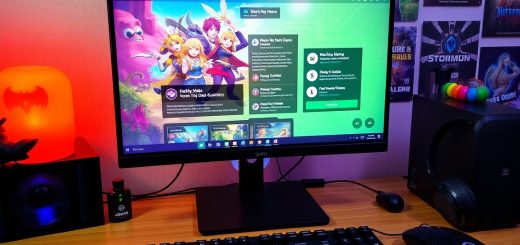The Evolution of Browser-Based Simulation Games
Have you ever stopped to think about how browser-based simulation games have quietly transformed the way we play and connect online? It’s pretty fascinating. These games started as simple, pixelated experiments but have exploded into rich, immersive worlds that millions dive into daily — all without downloading a thing. The evolution here is more than just tech upgrades; it’s about how these games rewrote the rules of entertainment and interaction on the web.
Back in the early days, browser games were limited by slow internet speeds and clunky web tools. But that didn’t stop developers from dreaming big. They crafted clever simulations that let players build cities, manage farms, or run businesses right in their browsers. What made these games stand out was their accessibility — anyone with an internet connection could jump in instantly. No installs, no fuss. It was like having a tiny game console right inside your browser window.
As technology surged forward, so did the possibilities. The arrival of HTML5 and more powerful JavaScript engines breathed new life into browser games. Suddenly, the graphics got sharper, the gameplay grew deeper, and servers could handle complex multiplayer interactions. This wasn’t just about prettier visuals; it was about creating dynamic, living worlds where players could interact in real time. The browser became a stage for experiences that rivaled traditional desktop games.
But here’s the kicker — the true magic lies in the communities these games foster. Players don’t just click buttons; they form friendships, rivalries, and entire cultures. Forums buzz with strategies, fan art, and stories. Some games even sparked social movements or inspired real-world events. It’s a reminder that games aren’t just about pixels on a screen; they’re about people coming together, sharing moments, and building something bigger than themselves.
So, when you think about browser-based simulation games, don’t just see them as simple pastimes. They’re a testament to how creativity, technology, and human connection can combine to reshape entertainment. From humble beginnings to complex universes, these games continue to evolve — inviting us all to play, imagine, and connect in ways we never thought possible.
Early Beginnings and Popular Titles
When you think about browser-based simulation games today, it’s easy to forget how humble their beginnings were. Back in the late 1990s and early 2000s, the internet was a different place—slower, simpler, and much less flashy. Yet, even then, developers were dreaming big, crafting games that could run right inside your browser without the need for heavy downloads or expensive hardware. These early titles were like pioneers, blazing a trail for what was possible in web gaming.
One of the key attractions of these games was their accessibility. Anyone with an internet connection and a web browser could jump in, no special equipment required. This opened the door for a whole new kind of gaming community—one that was diverse, global, and eager for interactive experiences. Titles like Neopets and Habbo Hotel weren’t just games; they were virtual worlds where players could socialize, trade, and create their own stories. They brought people together in ways that felt fresh and exciting.
Meanwhile, simulation games such as Travian and OGame introduced players to complex strategy and resource management, all within a browser window. These games were more than just time-killers. They demanded planning, patience, and a bit of cunning—qualities that kept players coming back day after day. It’s fascinating how these titles managed to deliver depth and complexity despite the technical limits of their time.
What really set these early browser-based simulations apart was their innovative use of web technologies available at the time. Developers cleverly used simple HTML, basic JavaScript, and server-side scripting to create dynamic and engaging experiences. It was like watching a magician pull rabbits out of a hat—turning the limited tools into something surprisingly captivating.
Looking back, these games laid the groundwork for everything that followed. They proved that you didn’t need a powerful console or a high-end PC to enjoy rich, interactive gameplay. Instead, all you needed was a browser and a spark of creativity. This spirit of innovation and accessibility continues to shape browser-based simulation games today, reminding us that sometimes, the simplest beginnings can lead to the most remarkable journeys.
Technological Advancements Driving Growth
When you think about browser-based simulation games, it’s easy to underestimate the tech magic happening behind the scenes. But trust me, the journey from simple pixelated screens to rich, immersive worlds is nothing short of remarkable. Over the years, the evolution of web technologies has been the rocket fuel propelling these games forward, turning what was once a basic pastime into a vibrant, dynamic experience.
Remember the days when Flash ruled the web? Those early days were exciting but limited. Flash had its charm, but it was clunky, slow, and often a security risk. The real breakthrough came with HTML5. Suddenly, developers had a powerful tool that worked seamlessly across devices without plugins. This meant smoother animations, richer graphics, and faster load times—all crucial for keeping players hooked.
But HTML5 alone isn’t the whole story. JavaScript, the unsung hero of web development, has evolved dramatically. Modern JavaScript frameworks allow games to handle complex calculations and real-time interactions without bogging down your browser. This means you can manage entire virtual cities, intricate ecosystems, or sprawling empires—all from your browser tab. It’s like having a mini gaming console right in your laptop.
Let’s not forget about server-side advancements. Cloud computing and improved server architectures mean that multiplayer simulations can support thousands of players interacting simultaneously. Lag? Almost a thing of the past. This shift has transformed browser games from solitary experiences into thriving social hubs where communities form, collaborate, and compete.
Here’s a quick snapshot of key technologies driving this growth:
- HTML5: Rich media support and cross-platform compatibility.
- JavaScript & WebAssembly: Faster, more efficient game logic and rendering.
- WebSockets: Real-time communication for multiplayer gameplay.
- Cloud Servers: Scalable infrastructure supporting large player bases.
All these advances have made browser-based simulation games more than just quick distractions. They’ve become complex, engaging worlds that invite players to dive deep, strategize, and connect. It’s fascinating how a few lines of code can create entire universes that millions explore daily. And as technology continues to advance, the future? Well, it looks incredibly exciting.
Cultural Impact and Community Engagement
When you think about browser-based simulation games, you might picture just clicking around a screen, but there’s so much more bubbling beneath the surface. These games have done something pretty incredible—they’ve built communities that feel like second homes. Imagine logging in not just to play, but to chat, strategize, and even make friends with people from all over the world. It’s like a digital campfire where stories are shared, alliances are forged, and rivalries spark, all within the virtual worlds these games create.
The cultural footprint of these games is surprisingly deep. They’ve influenced how we interact online by blending gameplay with social spaces. People don’t just compete; they collaborate, celebrate, and sometimes even organize real-life meetups. This blend of fun and fellowship has helped shape a new kind of online culture—one where players aren’t just users, but active participants in a shared experience. It’s a far cry from the lonely single-player games of the past.
What’s fascinating is how these games mirror real-life social dynamics. Players often take on roles like leaders, traders, or builders, which encourages teamwork and negotiation. These interactions foster skills like communication and problem-solving, but wrapped up in a package that feels like play, not work. The games become a social experiment in miniature, showing us how communities grow and thrive in digital spaces.
Plus, the accessibility of browser-based games breaks down barriers. You don’t need fancy hardware or downloads—just a browser and an internet connection. This inclusivity means a wider variety of people can join in, bringing diverse perspectives and cultures into the mix. It’s a melting pot of ideas and experiences, all converging in these virtual worlds.
To put it simply, browser-based simulation games have become more than entertainment. They’re cultural hubs and social catalysts. They remind us that at the heart of gaming lies connection—the human urge to belong, share, and create together. And that’s a powerful thing.
Frequently Asked Questions
- What exactly are browser-based simulation games?
Browser-based simulation games are interactive games played directly in your web browser without needing downloads or installations. Think of them as virtual playgrounds where you can manage cities, run businesses, or even simulate life scenarios, all through simple clicks and strategic decisions. They’re designed to be accessible, engaging, and often social, making complex systems feel like a fun puzzle rather than a chore.
- How did these games get started?
Back in the early days of the internet, developers experimented with simple text and pixel-based games that ran on basic web technologies like Flash and Java applets. Titles like “Neopets” and “The Sims Online” laid the groundwork by combining creativity with social interaction. These pioneers showed the world that you could have rich, immersive experiences without leaving your browser, sparking a whole new genre of gaming.
- What role do modern web technologies play in these games?
Thanks to advancements like HTML5, JavaScript, and powerful web servers, browser-based simulations have exploded in complexity and visual appeal. No longer limited to clunky graphics or slow loading times, today’s games boast smooth animations, real-time multiplayer features, and dynamic content updates. It’s like upgrading from a flip phone to a smartphone—the experience is just way more immersive and responsive.
- Why are these games so popular in online communities?
They tap into our love for social interaction and shared goals. Many browser-based simulation games encourage collaboration, competition, and community building, making them virtual meeting spots where players bond over strategy and creativity. Plus, their accessibility means anyone with an internet connection can join in, turning casual gamers into passionate communities overnight.
- Are browser-based simulation games still relevant in the age of mobile apps and consoles?
Absolutely! While mobile apps and consoles offer their own thrills, browser-based games hold a unique charm by being instantly accessible and often free-to-play. They serve as a gateway for new gamers and a quick entertainment fix for veterans. Plus, the continuous evolution of web tech keeps pushing their boundaries, ensuring they stay fresh, surprising, and downright addictive.
- Can I expect surprises or unexpected events in these games?
Definitely! Many simulation games incorporate random events, challenges, or “explosions” of activity that keep you on your toes. Imagine managing a city and suddenly facing a natural disaster or an economic boom—these twists add excitement and depth, making every playthrough feel like a new adventure rather than a repetitive task.
- How do browser-based simulation games impact culture and online interaction?
These games have become virtual hubs where culture, creativity, and social trends converge. They influence how people connect, collaborate, and even learn online. From fostering teamwork to inspiring fan art and storytelling, their cultural footprint extends far beyond just entertainment, shaping digital social landscapes worldwide.


